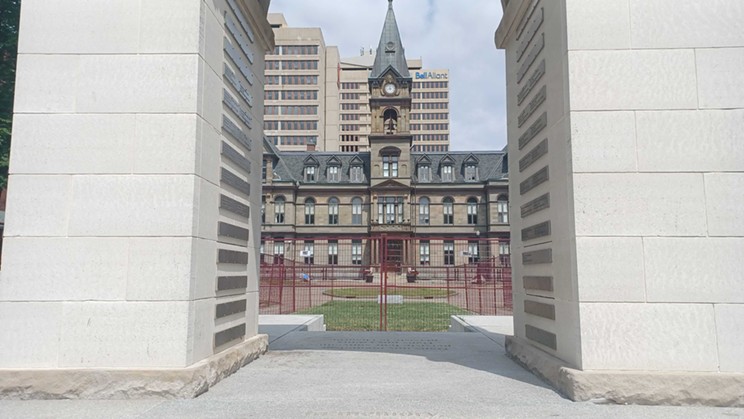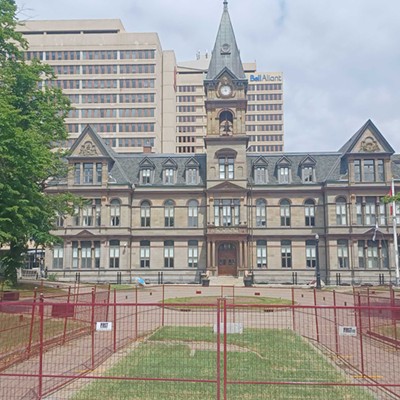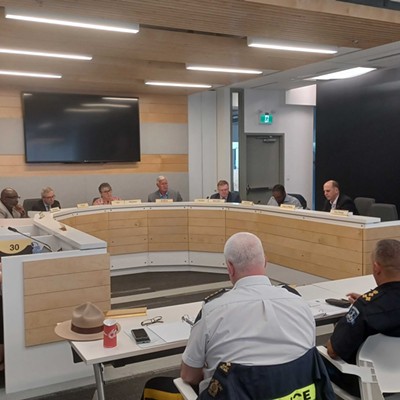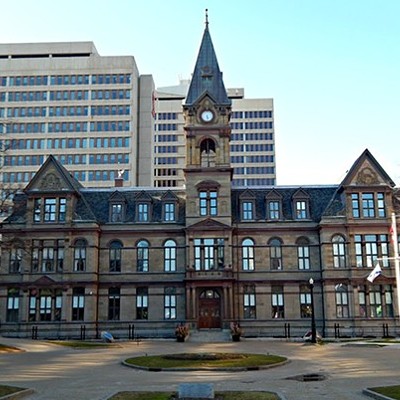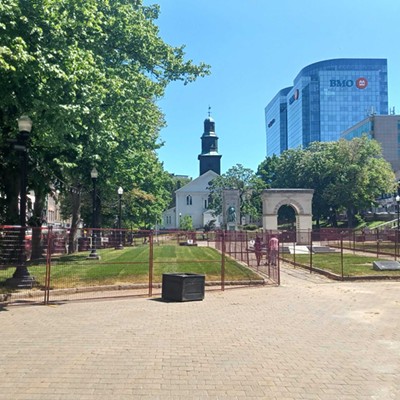There was an item added to Tuesday’s council meeting and it was a bit of a stinker. As reported by the CBC there’s nowhere for the poop in septic tanks to go anymore. The one place close to the HRM in Hants no longer has space to accept everyone’s feces so now septic companies will have to drive human waste out to Amherst. It’s a bit of a shit situation all around so councillors Pam Lovelace and Patty Cuttell have teamed up and asked the Chief Administrative Officer to figure out what can be done to make sure getting rid of number twos is a number one priority. Hopefully city staff come back with an expedited excrement plan as this motion was approved.
Things that passed
Deferred from last meeting, the emergency management documentation review was not really debated as everyone generally understands the importance of fixing our emergency plans as we enter into an era of climate emergencies. It passed unanimously.
1735 Henry St. became a heritage property after a public hearing at 1pm.
The city has two new Planner IIs but in order for new hires Aaron Bliss and Michael Hart to be able to do their jobs effectively they need to be officially anointed as development officers.
Ditto Aaron Murnaghan, but as a heritage officer. These people became officers on the consent agenda.
For those who are new to their fandom of city politics right now, Halifax has a CAO who seems to be a low key equivalent to Sidney Crosby or Connor McDavid if those two gentlemen were good at bureaucracy instead of hockey. Essentially, one of the marquee changes that happened at Halifax Water when she was in positions of leadership was that Halifax Water changed infrastructure management practices to ensure that they could maintain the infrastructure they built with the revenue they had.
Even though it seems like Halifax does not do this at the moment, during the presentation city staff told councillors that the city’s bureaucracy has been doing asset management in an ad hoc, unorganized kind of way. This has prevented the city from making good long term infrastructure decisions because staff have done things like prioritize getting $35 million in federal funding instead of prioritizing council’s strategic plans, or prioritizing functionality, or prioritizing fiscal sustainability. Staff expect to have this plan in place in time for the city’s massive strategic policy refresh scheduled for right after the next election and right before the start of the new four year budget process planned for next budget season. We’re mixing metaphors, but council has hit it clean and it’s going long. This one has potential to be a home run.
There’s no safe or legal way for people who live in the Sackville Manor Mobile Home Park to walk or bike to the transit terminal on the other side of highway 101. Even though our traffic engineers like to pretend otherwise, safety or legality obviously doesn’t stop people from taking the path of least resistance, which in this case is crossing a highway on foot. Councillor Paul Russell wants a bridge built over the 101 and this motion passed. Now the city will ask the province for money to build it, and either way, we can expect this in next year’s capital budget.
Speaking of the capital budget, the Windsor Street exchange's new plan is back for council’s consideration. The report can be found here and the technical attachments can be found here. On page 14 of the report staff explain why they are doing their best to kill council’s Bus Rapid Transit plan when they write that due to space constraints (and being unwilling to remove space from car traffic), the proposed design configuration does not incorporate dedicated transit lanes through the study area, which would be ideal for reducing delay for buses and accommodating future transit service including the BRT. Pretty neat that staff have decided to not follow the will of council and sabotage the long-term success of council’s BRT to instead prioritize car traffic! This was amended and passed, more details in the notable debates section below.
Lockview high school is likely going to get an all-weather track field at some point Soon™ as this passed.
The bylaw tweaks to crackdown on litterbugs coming from the Environment and Sustainability Standing Committee came in front of council and got approval. For more details on this you can read my coverage from that committee meeting here:
Councillor Sam Austin is trying to stop the infilling of Dartmouth Cove and his motion to do that has passed, now we wait and see if it’ll do anything.
Because councillors keep taxes low, parks staff can’t maintain trails to an adequate standard. So now councillor Patty Cuttell wants staff to figure out how to mitigate council’s decision to starve parks of the funding it needs to maintain HRM’s trails. This passed.
And a lot of in-camera stuff too.
Notable Debates
The Windsor Street Exchange debate was the flagship debate of this council meeting and the most interesting parts of this debate were from staff. Essentially there is money available from the feds and the port totaling about $37 million. The port, for its $2 million contribution, wants truck traffic to be less congested coming out of the port. The feds, for their $35 million want things like transit priority and reduced greenhouse gas emissions. The total cost of the project right now is about $103 million.
Generally speaking this new design was panned by councillors. Staff were quick to point out that this project will reduce greenhouse gas emissions because the modeling shows car traffic will increase 12% but the new design is so efficient there will be a reduction in greenhouses gasses due to the reduction in idling. However, cars emit 400 grams of carbon per mile travelled and about 115 grams of carbon per five minutes of idling. For context, from the Windsor Street Exchange to Dartmouth on the MacKay a car will emit about 800 grams of carbon over that three-kilometre trip. Right now about 90,000 to 110,000 cars travel through the Windsor Street Exchange. To use 100,000 for easy math, if the new design prevents 100,000 cars from idling for five minutes, that's 11,500,000 grams of Co2 emissions removed. Adding 12% more cars is adding roughly 22,400,000 grams of Co2 which is a net gain in Co2 emissions. It is unclear why staff think this would qualify for funding from the federal government if one of the requirements is reducing greenhouse gas emissions. Transport Canada did not answer what impact this would have on Halifax’s application in time for publication.
Councillor Waye Mason lambasted staff (politely) saying that council has directed staff to prioritize bike and bus travel, so why is it that staff did not prioritize bus travel. Staff responded by saying that they could have prioritized bus travel, but that would have required not prioritizing car travel, so they decided to ignore council instruction to prioritize car travel to keep the $2 million in funding from the port.
Councillor Sam Austin pointed out that people use the transportation infrastructure that is built for them, and prioritizing car travel would make more people drive through the Windsor Street Exchange. He wanted to know why staff did not factor in induced demand and the expected increased car traffic. Staff responded that more people using the exchange in cars is just a fact (it’s not, it’s a design choice) but staff haven’t explicitly tried to figure out the impact of building out car infrastructure on council’s modal shift goals, which are to reduce car traffic. Swing and a miss from staff for Austin.
Mason came back into the debate to amend the motion directing staff to “include the following considerations” of better active transit planning, a dedicated bus lane all the way through the exchange, planning for a pedestrian connection to the planned MacKay replacement and an analysis of the expected increase in car traffic. Mason had initially planned to defer the motion, but due to the fact that this is a planning process with several stages he expects the amendment to change the design substantially before it comes back to council.
Councillor Shawn Cleary blasted the language in the motion saying it was weak and that staff have already considered all of the things Mason’s motion is again directing them to do, but after those considerations staff still came back with this carbage (pun intended) plan. Cleary asked city staff if they had already done all of these considerations before coming to council today. Staff said that yes, they had considered council’s priorities but in order to follow council’s instructions they would have to give transportation space to buses which would prevent staff from maintaining staff’s desired level of car traffic. Cleary snapped back that staff’s response did not fill him with confidence.
Cleary also pointed out that the price tag of the project is now over $100 million, but the contributions from the port and feds have not increased, just the municipal portion. He wanted to know why we were bending over backwards to accommodate other people’s plans and ruining council’s plans when the city was the majority funder of the project. Staff had no good answer for that because there is no good answer for that. It’s just straight up bad governance and a bit of a staff mutiny.

